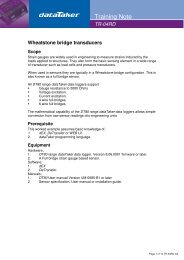You also want an ePaper? Increase the reach of your titles
YUMPU automatically turns print PDFs into web optimized ePapers that Google loves.
Example<br />
J1939 PGN 65254 may be used to request the current time setting from an ECU. This PGN contains separate fields for<br />
hours, minutes and seconds. It is important that this PGN be queried using a single request, otherwise the time may roll over<br />
to the next minute/hour between requests, leading to an incorrect reading.<br />
The following group of slot definitions will, when polled (using RP 1 3), return the current time in hh:mm:ss format.<br />
BEGIN<br />
1 RQSTJ 1 65254 3 3 FORMAT "%02d:" ' hours<br />
2 RQSTJ 1 65254 2 2 FORMAT "%02d:" ' minutes<br />
3 RQSTJ 1 65254 1 1 FORMAT .25 "%0.f\n" ' seconds<br />
END<br />
Sending the following slot #0 definitions in quick succession would have the same effect:<br />
RQSTJ 1 65254 3 3 FORMAT "%02d:"; RP<br />
RQSTJ 1 65254 2 2 FORMAT "%02d:"; RP<br />
RQSTJ 1 65254 1 1 FORMAT .25 "%0.f\n"; RP<br />
Multi-Packet J1939 Messages<br />
An ECU on a J1939 network may periodically broadcast multi-packet messages for one or more PGNs. These messages<br />
are used when the PGN contains more than 8 bytes of data. A message consists of a header CAN frame (containing the<br />
PGN number and message length), followed by one or more CAN frames, each containing up to 7 bytes of data.<br />
It is possible for two or more broadcast messages to overlap, in which case some or all of their constituent CAN frames will<br />
be interleaved. <strong>CANgate</strong> can track a certain number of simultaneous multi-packet messages. Be aware of the following<br />
limitations:<br />
Only one RECVJ slot can reference a data field of size greater than 8 bytes.<br />
Multiple RECVJ slots can reference data fields up to 8 bytes in size within a multi-packet message.<br />
If there are RECVJ slots which reference data fields (up to 8 bytes) from three or more different multi-packet PGNs<br />
then this will work provided that the ECU does not transmit more than two of these PGNs at the same time.<br />
There are no restrictions for RQST/RQSTJ slots, because only one request can be active at any one time.<br />
Terminal Control<br />
The following example is intended to be used with an ANSI/VT100 terminal or emulator. Two data values are extracted from<br />
received CAN messages with ID 0x212, and one from ID 0x444 messages. These values are displayed at particular<br />
row/column positions on the terminal (using the ANSI ESC[row;colH sequence), and are then updated once per second.<br />
CONNECT 2 250<br />
BEGIN<br />
1 RECV 2 0x212 1 3 1000 FORMAT "\027[1;10HEngine Speed: %6f rpm"<br />
2 RECV 2 0x212 4 5 1000 FORMAT "\027[2;10H Temp: %6.1f degC"<br />
3 RECV 2 0x444 1 3 1000 FORMAT "\027[3;10H Gear: %3d"<br />
END<br />
This should display the data on the terminal as follows:<br />
Engine speed: 2310 rpm<br />
Temp: 39.2 degC<br />
Gear: 4<br />
KWP2000/OBD-II/ISO-14230 Requests<br />
Keyword Protocol 2000 (KWP2000) is a widely used poll-response protocol that allows diagnostic equipment to query and<br />
control ECUs on an automotive network.<br />
As discussed in RQST – Request OBD Data (P17), the basic structure of KWP2000 is defined in ISO 14230-3. This standard<br />
defines various request messages, each of which consists of a single byte service identifier, or mode byte, usually<br />
followed by a number of parameters. Reply messages also begin with a mode byte which is derived from the mode byte of<br />
the request.<br />
KWP2000 modes 0x00-0x0F are reserved for standardised legislated OBD (on board diagnostics) functions, and are<br />
defined in SAE J1979 / ISO-15031. Modes 0x10-0x3F are functionally defined by ISO-14230-3, but the details of parameters<br />
and response data format tend to be manufacturer specific.<br />
Each ECU parameter that can be requested or set is identified by a PID (parameter identifier) code. For the legislated OBD<br />
functions, the PID codes are standardised; for the ISO-14230-3 functions the PID definitions are manufacturer specific.<br />
Example<br />
In this example, the engine speed is requested. From ISO-15031 (or the Appendix, OBD-II Modes and PIDs (P40), we know<br />
that the Engine RPM is PID 0x0C, and the returned value has a resolution of 0.25 rpm and an offset of 0. KWP2000 mode<br />
0x01 indicates a request for the current value of a PID. The complete request message therefore contains two bytes: the<br />
UM-0086-A2 <strong>CANgate</strong> User’s <strong>Manual</strong> Page 30



